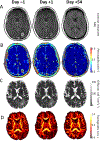CNS metastases in breast cancer: old challenge, new frontiers
- PMID: 24298071
- PMCID: PMC7580496
- DOI: 10.1158/1078-0432.CCR-13-0790
CNS metastases in breast cancer: old challenge, new frontiers
Abstract
Despite major therapeutic advances in the management of patients with breast cancer, central nervous system (CNS) metastases remain an intractable problem, particularly in patients with metastatic HER2-positive and triple-negative breast cancer. As systemic therapies to treat extracranial disease improve, some patients are surviving longer, and the frequency of CNS involvement seems to be increasing. Furthermore, in the early-stage setting, the CNS remains a potential sanctuary site for relapse. This review highlights advances in the development of biologically relevant preclinical models, including the development of brain-tropic cell lines for testing of agents to prevent and treat brain metastases, and summarizes our current understanding of the biology of CNS relapse. From a clinical perspective, a variety of therapeutic approaches are discussed, including methods to improve drug delivery, novel cytotoxic agents, and targeted therapies. Challenges in current trial design and endpoints are reviewed. Finally, we discuss promising new directions, including novel trial designs, correlative imaging techniques, and enhanced translational opportunities.
©2013 AACR.
Figures





References
-
- Barnholtz-Sloan JS, Sloan AE, Davis FG, Vigneau FD, Lai P, Sawaya RE. Incidence proportions of brain metastases in patients diagnosed (1973 to 2001) in the Metropolitan Detroit Cancer Surveillance System. J Clin Oncol. 2004;22:2865–72. - PubMed
-
- Fokstuen T, Wilking N, Rutqvist LE, Wolke J, Liedberg A, Signomklao T, et al. Radiation therapy in the management of brain metastases from breast cancer. Breast cancer research and treatment. 2000;62:211–6. - PubMed
-
- Kennecke H, Yerushalmi R, Woods R, Cheang MC, Voduc D, Speers CH, et al. Metastatic Behavior of Breast Cancer Subtypes. J Clin Oncol. 2010. - PubMed
-
- Pestalozzi BC, Zahrieh D, Price KN, Holmberg SB, Lindtner J, Collins J, et al. Identifying breast cancer patients at risk for Central Nervous System (CNS) metastases in trials of the International Breast Cancer Study Group (IBCSG). Ann Oncol. 2006;17:935–44. - PubMed
Publication types
MeSH terms
Substances
Grants and funding
LinkOut - more resources
Full Text Sources
Other Literature Sources
Medical
Research Materials
Miscellaneous

